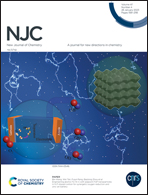Asymmetric {Dy4} metallogrid and double-layered {Dy8} cage clusters from carboxylic decorated o-vanillin Schiff bases: syntheses, topological variation, and single molecule magnet behaviors†
Abstract
There is still great potential to be tapped for polynuclear lanthanide single-molecule magnets (Ln-SMMs) for performance. Toward this goal, the exploration of polynuclear lanthanide clusters (PLnCs) with novel special topologies is critical. Herein, two novel PLnCs, [Dy4(ov6ca)6(CH3OH) (H2O)2]·6CH3OH·CH3CN·H2O (1) and [Dy8(ov5ca)6(a5ca)4(ov)2(μ-OH)6]·6CH3OH (2), have been synthesized, where ov6ca2−, ov5ca2−, a5ca−, ov− represent the ions of 2-[(o-vanillidene)amino]-6-chlorobenzoic acid, 2-[(o-vanillidene)amino]-5-chlorobenzoic acid, 2-amino-5-chlorobenzoic acid and o-vanillin, respectively. Carboxylic decorated o-vanillin Schiff base ligands H2ov6ca and H2ov5ca, were constructed as 1 and 2, respectively, and only differ in the position of a Cl-substituent. However, this tiny difference has induced great variation in the nuclearity and topology between 1 and 2. Cluster 1 features a {Dy4} metallogrid core, where four DyIII ions are bridged by two Ophenol and two carboxylate groups from ov6ca2− ligands but show different coordination geometries. To our knowledge, it is the first {Ln4} cluster with such an asymmetric metallogrid topology. While 2 displays a rare double-layered cage cluster topology, in which a pair of butterfly-shaped {Dy4} units were linked together by four carboxylate groups from ov5ca2− ligands. Magnetic measurements revealed that both 1 and 2 exhibit slow magnetic relaxation behavior, with efficient energy barrier (Ueff) values of 93.06 and 66.92 K, respectively.



 Please wait while we load your content...
Please wait while we load your content...